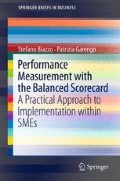Abstract
In this chapter performance measurement system is described as a balanced and strategic system that is able to support the decision-making process by gathering, elaborating and analysing critical information. The search for balance of the measurement system is a way to support and make explicit the need for abandoning the model of opportunistic search for profit, in favour of a circular and holistic vision of the concept of entrepreneurial success. The looking for strategic alignment underlines the need to create a system focusing on a limited number of critical phenomena that lead an enterprise to finding a specific position in the industry and to taking advantage of specific internal resources and competencies.
The design of a strategic and balanced dashboard may be based upon various reference models; in this chapter, we focus out attention on the Balanced Scorecard as it is the most diffused, easy to understand and renowned model at the international level.
Access this chapter
Tax calculation will be finalised at checkout
Purchases are for personal use only
References
Becker BE, Huselid MA, Ulrich D (2001) The HR scorecard: linking people, strategy, and performance. Harvard Business School Press, Boston
Cameron K, Quinn E (1999) Diagnosing and changing organizational culture. Addison-Wesley, New York
Coda V, Mollona E (2006) Dynamics of strategy: a feedback approach to corporate strategymaking. In: Minati G, Pessa E, Abram M (eds) Systemics of emergence: research and development. Springer, New York
Daniel DR (1961) Management information crisis. Harv Bus Rev 39(5):111–121
De Waal A (2007) Strategic performance management. A managerial and behavioural approach. Pagrave Macmillan, New York
Eccles R (1991) The performance measurement Manifesto. Harv Bus Rev 69:131–137
Garengo P (2009) Performance measurement system in SMEs taking part in quality award programs. Total Qual Manage Bus Excell 20:91–105
Horton S (2000) Introduction. The competency movement: its origins and impact on the public sector. Int J Public Sect Manage 13:306–318
Kaplan R, Norton D (1992) The balanced scorecard: the measures that drive performance. Harv Bus Rev 70:71–79
Kaplan R, Norton D (1996) Using the balanced scorecard as a strategic management system. Harv Bus Rev 74:75–85
Kaplan RS, Norton DP (1999). The Balanced Scorecard. Harvard University Press, Boston, Massachusetts
Kaplan R, Norton D (2001) Transforming the balanced scorecard from performance measurement to strategic management: part I. Account Horiz 15:87–104
Kaplan R, Norton D (2003) Strategy maps: converting intangible assets into tangible outcomes. Harvard Business School Press, Boston
Kaplan R, Norton D (2008) Execution premium. Linking strategy to operations for competitive advantage. Harvard Business School Press, Boston
Neely A, Adams C, Kennerley M (2002a) The performance prism: the scorecard for measuring and managing stakeholder relationship. Prentice Hall, London
Neely A, Bourne M, Mills J, Platts K, Richards R (2002b) Getting the measure of your business. Cambridge University Press, Cambridge
Neely A, Gregory M, Platts K (2005) Performance measurement system design: A literature review and research agenda. Int J Oper Prod Manage 25(12):1228–1263
Niven PR (2002) Balanced scorecard step-by-step: maximizing performance and maintaining results. Wiley, New York
Rockart JF (1979) Chief executives define their own data needs. Harv Bus Rev 57:81–93
Shook J (2008) Managing to learn. The Lean Enterprise Institute, Cambridge, MA
Spencer LM, Spencer SM (1993) Competence at work models for superior performance. Wiley, New York
Thiétart RA, Forgues B (1995) Chaos theory and organization. Organ Sci 6:19–31
Ulrich D (1997) Measuring human resources: an overview of practice and a prescription for results. Hum Resour Manage 36:303–320
Author information
Authors and Affiliations
Corresponding author
Rights and permissions
Copyright information
© 2012 Springer-Verlag Berlin Heidelberg
About this chapter
Cite this chapter
Biazzo, S., Garengo, P. (2012). Measuring Business Performances: The Balanced Scorecard Model. In: Performance Measurement with the Balanced Scorecard. SpringerBriefs in Business. Springer, Berlin, Heidelberg. https://doi.org/10.1007/978-3-642-24761-3_1
Download citation
DOI: https://doi.org/10.1007/978-3-642-24761-3_1
Published:
Publisher Name: Springer, Berlin, Heidelberg
Print ISBN: 978-3-642-24760-6
Online ISBN: 978-3-642-24761-3
eBook Packages: Business and EconomicsBusiness and Management (R0)

